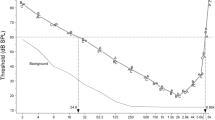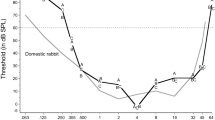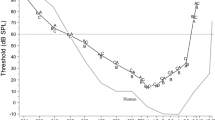Abstract.
The audiogram of two yearling male reindeer (Rangifer tarandus tarandus) were determined using a conditioned suppression/avoidance procedure. During testing, the animal was drinking from a metal bowl while pure tone signals were played at random intervals and followed by an electric shock in the bowl. By breaking contact with the bowl at sound signals, the animal avoided the shock. The animals detected sounds at intensities of 60 dB or less from 70 Hz to 38 kHz. The frequency range of best sensitivity was relatively flat from 1 kHz to 16 kHz, with a best sensitivity of 3 dB at 8 kHz. The hearing ability of reindeer is similar to the hearing ability of other ungulates.
Similar content being viewed by others
Author information
Authors and Affiliations
Additional information
Electronic Publication
Rights and permissions
About this article
Cite this article
Flydal, K., Hermansen, A., Enger, P.S. et al. Hearing in reindeer (Rangifer tarandus). J Comp Physiol A 187, 265–269 (2001). https://doi.org/10.1007/s003590100198
Accepted:
Issue Date:
DOI: https://doi.org/10.1007/s003590100198




